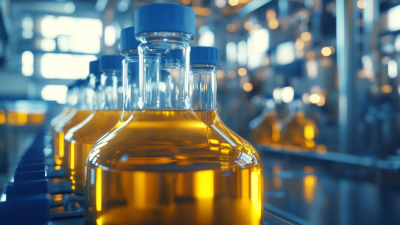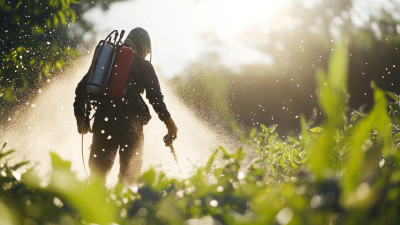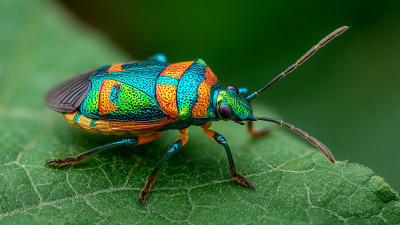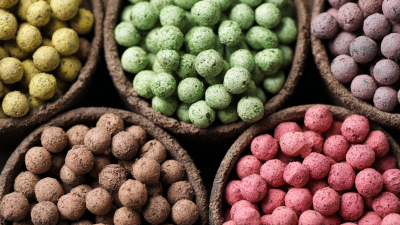 0551-68500918
0551-68500918 





Lately, farmers and agribusinesses have been really exploring new ways to grow crops sustainably. One tool that's been gaining a lot of attention is Glyphosate Liquid. It’s a pretty popular herbicide because it works well across different crops and effectively keeps weeds at bay. According to the FAO, worldwide, we’re using about 1.8 million tons of glyphosate each year — that just shows how important it is in helping farmers boost their yields and run their farms more efficiently. That said, people are also worried about its environmental and health impacts, which has sparked plenty of debates.

Innovation Meiland (Hefei) Co., LTD. is really stepping up to the plate here, trying to tackle these concerns by creating new pesticide formulas designed to get the most out of Glyphosate Liquid while keeping risks as low as possible. With a focus on research and innovation, they’re really aiming to support farming practices that are both productive and safe — you know, trying to find that good balance.
Glyphosate liquid has really become a game-changer in sustainable farming. It’s boosted crop yields and made farming operations way more efficient. According to a report from the CropLife Foundation, crops engineered to resist glyphosate have seen an average yield bump of about 10 to 20% across different types of farming systems. Basically, this herbicide makes weed control way easier, cutting down on the competition for nutrients, water, and sunlight, which helps the crops grow better. Back in 2021, the USDA’s Economic Research Service pointed out that using glyphosate actually contributed to a multi-billion dollar boost in the US agriculture sector — pretty impressive, right? It just shows how crucial it is for maximizing productivity.
Plus, glyphosate plays a big role in conservation tillage methods, which are great for soil health and helping prevent erosion. A study published in the Journal of Environmental Quality revealed that fields treated with glyphosate had about 30% less soil erosion compared to those managed with traditional tillage. Less soil disturbance means the soil stays healthier, with better structure and microbial life, and it even helps trap more carbon — making farming more sustainable overall. So yeah, while it's important to stay aware of the risks, the clear benefits in yield and environmental preservation really show how essential glyphosate has become in modern, eco-friendly farming.
You know, there's been a lot of talk lately about how glyphosate impacts soil health and the tiny microorganisms that live there. It’s pretty eye-opening because glyphosate, that common herbicide we all know, doesn’t just help control weeds—it might actually be messing with the soil’s ecosystem too. Recent studies suggest that when farmers use glyphosate, it can change the makeup of those microbial communities, sometimes knocking out the good guys that help plants grow and keep the nutrients cycling properly. Honestly, that’s a bit worrying since these microbes are crucial for healthy soil and thriving crops.
And here’s the thing—if glyphosate sticks around in the soil for a long time, it can cause some pretty serious changes in how the soil functions overall. Researchers have found this interesting pattern: at lower levels, the impact seems kinda manageable, but once the residue gets higher, it can really mess things up, hitting the microbial activity hard and throwing the whole ecosystem off balance.
This isn’t just about crops either—these shifts could threaten the broader biodiversity, soil health, and even food security down the line. It's a complex issue, and it’s definitely worth paying attention to.
Talking about the economic side of using glyphosate in sustainable farming… well, it’s honestly pretty complicated. Glyphosate is this really common herbicide that, when used right, can help farmers boost their crop yields. How? By knocking down weeds that steal nutrients and water from the plants they’re trying to grow. This means lower costs and greener profits, especially when you’re aiming for sustainable farming practices. Plus, with glyphosate, farmers can do conservation tillage — which is awesome because it’s better for the soil, helps prevent erosion, and is good for the planet in the long run.
But, here’s where things get tricky. Relying too much on glyphosate can also create some economic headaches. For instance, weeds can develop resistance, which might mean farmers end up spending more on other weed control methods and might even see their yields drop again down the line. And then there’s all the fuss about whether glyphosate is safe. That controversy can actually mess with market access and how consumers view their food, which can hit farmers' wallets too. So, finding that balance — weighing the short-term gains against the long-term sustainability — is really important. Basically, glyphosate can definitely help keep sustainable farming economically viable, but it’s crucial to keep an eye on the risks so that we’re not sacrificing the health of our environment or the future of farming for quick wins.
Glyphosate (GLY) is still the most commonly used herbicide worldwide — pretty much essential for keeping weeds in check in farming. That said, there’s a growing concern about its environmental impact, especially when it comes to water contamination from its breakdown product, aminomethylphosphonic acid (AMPA). Recent studies from around the globe show that more than half of the glyphosate and AMPA ending up in rivers actually comes from corn and soy farming. This really highlights the urgent need for stricter regulations and more sustainable farming practices. In Brazil, herbicide use skyrocketed by 128% between 2010 and 2020, with chemicals making up about 59% of total agrochemical sales — way above the worldwide average of 52%. It’s clear that reliance on Chemical Weed Control is growing fast there.
On top of that, we can’t ignore the potential health and ecological risks. Research so far suggests that a single application doesn’t do much to soil microbes, but what really worries experts is the long-term effects — which we still don’t fully understand. That’s why ongoing research into glyphosate’s safety and sustainability is so important. Recently, Mexico announced plans to ban glyphosate completely by 2024, which is a big move and part of a broader global conversation about its environmental dangers. At Innovation Meiland, we’re dedicated to developing new pesticides and smarter processes that not only help farmers succeed but also minimize environmental harm. It’s all about finding a better way to keep agriculture thriving without compromising our planet.”

Using glyphosate liquid as part of sustainable farming practices can really help manage weeds better while keeping the environment in mind. The key is understanding how it fits into conservation tillage methods, which are great for maintaining healthy soil and reducing erosion. Farmers should think about using glyphosate along with cover crops — those plants that grow between main crops — because they can help keep weeds at bay and, at the same time, boost soil health. Doing it this way not only leads to higher yields but also supports a more balanced ecosystem.

A couple of tips: keep a close eye on how much glyphosate you're applying — sticking to recommended amounts is super important. Pairing herbicide use with cultural practices like crop rotation can also cut down on relying solely on chemicals. And don’t forget to keep good records of how much glyphosate you use — this way, you can see how it’s affecting your crops and the environment over time.
Another smart move is adopting an integrated pest management (IPM) approach, where glyphosate is just one tool in a toolkit that includes other methods. This helps prevent weeds from becoming resistant and supports more biodiversity on the farm. Lastly, teaming up with ag professionalsto review your farm’s specific needs can really help tailor your Glyphosate Use, making sure it lines up with yoursustainability goals — it’s all about doing things smarter, not just harder.
You know, the whole idea of using glyphosate in farming has become a bit of a hot topic these days. People are really talking about how safe it is and what rules should be in place. In the UK, there's this thing called the Pesticides National Action Plan 2025, which pretty much focuses on pushing for more eco-friendly farming while still making sure pesticide regulations are strict. They've been reviewing how glyphosate is used, especially since some folks are pushing to allow more of it on certain crops, which has sparked a lot of debate. Lately, both farmers and everyday consumers are getting more worried about what glyphosate might do to our health — like, could it be linked to cancer or other serious illnesses? It’s a concern that’s gaining a lot of attention.
From what science is saying, glyphosate works well as a weed killer, but there’s growing concern about what it might do in the long run. Some studies have pointed out that it can mess with cells and molecules in our bodies, which might affect things like fertility and reproductive health. Plus, tiny traces of glyphosate showing up in our food and environment aren’t doing much to boost people’s trust. That’s why many are asking for tougher safety checks. As rules around its use change, it’s so important for everyone involved in farming to find that sweet spot—being efficient and sustainable, but also really looking out for public health. It’s a tricky balance, but one we definitely need to get right.
| Aspect | Benefits | Risks | Regulatory Standards | Safety Measures |
|---|---|---|---|---|
| Effectiveness | High efficacy in weed control | Potential development of resistant weed species | EPA limits on residue levels | Regular training for application professionals |
| Crop Yield | Can improve crop yields by controlling pests | Possible soil degradation over time | Global harmonization of standards | Use of personal protective equipment (PPE) |
| Environmental Impact | Less tillage required, reducing carbon footprint | Impact on non-target organisms | National and regional environmental assessments | Buffer zones near water sources |
| Human Health | Food safety when used according to guidelines | Controversy over cancer risks | Compliance with maximum residue limits (MRLs) | Health monitoring of agricultural workers |
| Sustainability | Supports integrated pest management (IPM) | Long-term ecosystem disruption | Adherence to sustainable agriculture standards | Regular review of application methods |
: Glyphosate is the most widely utilized herbicide globally, essential for effective weed management in agricultural practices.
The primary environmental concerns include contamination of water bodies due to its by-product, aminomethylphosphonic acid (AMPA), and its significant contribution to water pollution from agricultural runoff.
Herbicide usage in Brazil increased by 128% between 2010 and 2020, making up 59% of the country’s agrochemical sales, which surpasses the global average of 52%.
Studies suggest that glyphosate has negligible impacts on soil microbiomes after single applications; however, the long-term effects on these ecosystems remain poorly understood.
The Mexican government has decided to implement a total ban on glyphosate by 2024, which reflects growing environmental sensitivity to its risks.
Best practices include using glyphosate in conservation tillage, alongside cover crops to suppress weeds, monitoring application rates closely, and adopting an integrated pest management (IPM) strategy.
Farmers can reduce reliance on chemical controls by combining glyphosate applications with cultural practices like crop rotation and maintaining accurate records of glyphosate use.
Using glyphosate with cover crops can enhance soil health, suppress weed growth, and ultimately boost crop yields.
Collaborating with agricultural professionals helps in assessing specific farm needs, leading to tailored applications of glyphosate that align with sustainable farming goals.
Advancing research and development of new pesticide formulations aims to mitigate environmental risks while sustaining agricultural productivity.
This article takes a closer look at the many roles that Liquid Glyphosate plays in sustainable farming—highlighting both the perks and the potential downsides. It's pretty well-known that Glyphosate Liquid can boost crop yields and make farming a bit more efficient, which is a huge help for farmers trying to get the most out of their land. That said, it’s really important to also think about how it affects the soil and the tiny microbes living there—since these are key for keeping agriculture sustainable in the long run.
We also get into the financial side of things—how Glyphosate Liquid fits into eco-friendly farming practices—and discuss the environmental risks that come with its use. The article suggests some best practices for using it responsibly, and reviews the rules and safety measures farmers should follow to stay on the right side of things. As Meiland Stock keeps pushing forward with game-changing pesticide solutions, understanding these issues around Glyphosate Liquid is more important than ever for developing farming methods that are both effective and sustainable.







